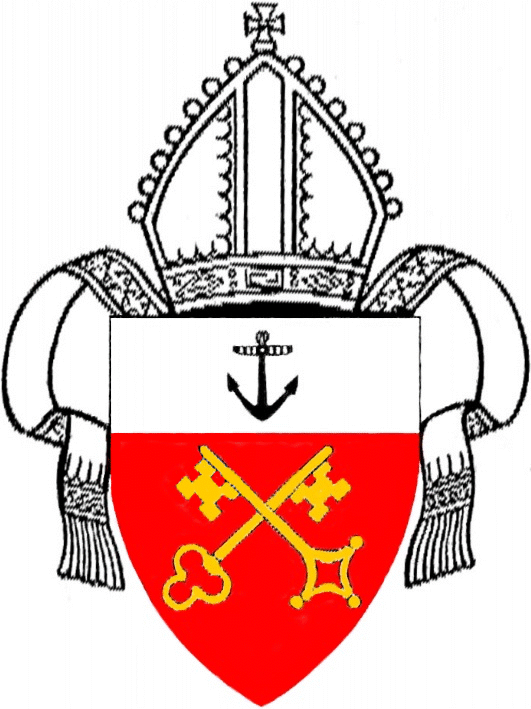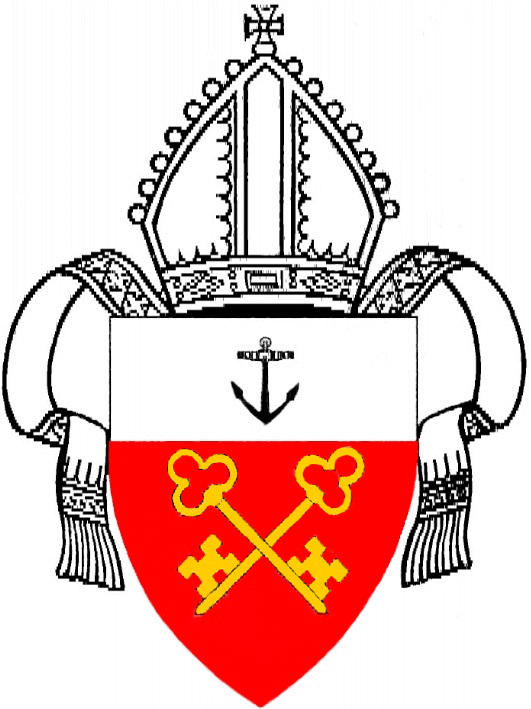DIOCESE OF LEBOMBO
Diocese established in 1893.
Cathedral: Pro-Cathedral of St Stephen and St Lawrence, Lourenço Marques; later St Augustine’s, Maciene.
variant
Arms apparently adopted by Bishop Smyth in 1893, and granted by the College of Arms under Letters Patent dated 29 May 1951. The blazon reads:
Gules, two Keys in Saltire wards downwards and outwards Or a Chief Argent thereon an anchor Sable.
Brownell writes: “The reason for the choice of the keys is unclear. The fact that the first bishop, William Edmund Smyth was, before his ordination at St Peter’s Clergy House in the London Docks, may have influenced the inclusion of keys, the symbols of St Peter. The anchor links these arms with the Metropolitan See.

“In the depiction of these arms in Crockford’s Clerical Directory prior to 1930, the bows of the keys are circular, while on the cover of the diocesan magazine Lebombo Leaves, the bows are lozenge-shaped and balled. These minor differences are irrelevant, since heraldry permits artistic interpretation of the blazon.”
Brownell also illustrates a variant of these arms as shown on a stained glass window in St George’s Cathedral, Cape Town. The blazon reads:
Gules, a pair of keys in saltire Or; on a chief Argent an anchor Sable.
Brownell writes: “In this stained glass version of the Diocesan arms, in the upper part of the Great Window, in the North Transept of St George’s Cathedral, Cape Town, the
wards of the keyw are upwards and outwards, which is the normal heraldic orientation of a pair of heraldic keys, unless otherwise stated, instead of downwards and outwards, as they should be in this particular coat of arms.”
About the diocese:
The diocese was established as a missionary venture in the Portuguese domain known as Africa Portuguesa Oriental (Portuguese East Africa), and Portuguese remains the lingua franca of the diocese.
Local dialects are also used by the church.
The diocese takes its name from the mountain range which marks the boundary between the then Portuguese territory to the east (now called Moçambique), and the Zuid Afrikaansche Republiek and Swaziland to the west.
At the time Bishop Smyth was sent to Lourenço Marques, this city was capital of a relatively small colony bearing the same name. The rest of the territory now known as Moçambique was divided into the provinces of Inhambane, Manhica and Sofala (administered by the Companhia de Moçambique), Zambezia (later divided into the colonies of Tete and Quelimane), Moçambique and Niassa (on the shores of what is now called Lake Malawi, which was administered by the Companhia de Niassa).
Brownell writes: “The northern part of this diocese became the Diocese of Niassa in 1978, and in 1991 Angola became an Archdeaconry of the Diocese of
Lebombo.”
Bishops:
The first Bishop of Lebombo was W E Smyth. After him came J L Fuller (consecrated 1913), L N Fisher (1921), B W Peacey (1929), D Victor (1936), J
Boys (1948), H Beevor (1952), S C Pickard (1958), D P dos S Pina Cabral (1969) and Dinis Sengulane (1976). Bishop Boys was in office when the diocese was granted arms by the College of Arms in 1951.



